We also had to try the questions. I suggest you give it a go now, too! Go on, before you peek at mine...
My solution looked like this:
I realised I was looking at it from the point of view of a maths graduate and teacher; I'm comparatively "good at maths", whatever that means. When I thought back about what I'd done, I'd automatically jumped to writing both fractions as fourteenths, because I'd "seen" the denominators 2 and 7. I knew I needed to use equivalent fractions, and that 1/2 is the same as 7/14.
But how many of my students really understand that? Given that I've had GCSE students ask me what an equivalent fraction is, possibly fewer than I assume. My "explanation" relies on a deep understanding of fractions, and presupposes a lot of things. When I tried this with my KS3 classes both last year and this year, the only students who immediately jumped to equivalent fractions, like I did, were those considered "high ability"; i.e. students in higher maths sets.
I went back to my paper, and decided to think how I would explain this when teaching it, or how a student who didn't think to use equivalent fractions might approach it.
However, what you're looking at there is attempt #5 at drawing sevenths on a circle. If you tried this problem, chances are, you drew a pizza too. And it probably took you several goes to get the sevenths looking right.
I think there were about 20 or so maths teachers there, and nearly all of us drew pizzas. When I took this away and did it with my KS3 classes, and then when I tried it again with them all this year, nearly all of them drew pizzas too. And, unsurprisingly, all of them found it at least as difficult as me to draw sevenths accurately. I've actually seen students draw things that cause conceptual misunderstandings, like this one:
Pizzas are pervasive in teaching fractions. I guess I can see why; most students will have seen pizzas cut up into pieces, but think about the size of those pieces. Order a takeaway pizza and it's usually sliced into eighths, with options for sixths or tenths occasionally, but never something difficult to cut, like ninths or sevenths. When I cook a pizza, I half, half and half again because that's the easiest way to get equal slices. I tried cutting a pizza into sevenths once, just for kicks. Unsurprisingly, I got something that looked like the picture above (and a very messy tea).
Maybe the pizza model is useful, but it's not the only thing we cut up and share out. I realised that I always supplied students with the example of pizza (or occasionally, a birthday cake), but never thought about using non-circular pictures, like a chocolate bar.
Secondly, there's a direct comparison - you really can see that 4/7 is bigger than 1/2, and even begin to see by how much. It's not a full seventh bigger, it looks more like half a seventh (and believe me, if you try this with a group of students and they go down that route, the discussion that comes out of that is invaluable).
This idea of rectangular modelling comes from Singapore. Over the last 18 months or so, I've seen and heard the words "Singapore bar model" more and more frequently in blogs and lesson plans. It seems to be the latest "trendy" idea in maths teaching, but don't dismiss it just because of that - it's actually really useful in loads of areas of maths.
I ask students to draw the diagrams in their books, and think carefully about how they can use the squares to help them. Inevitably I get a couple of these:
Depending on the class, it then goes one of two ways. I sometimes find that one or more students has naturally drawn something like this:
If no-one has done this, then I challenge students to redraw their original diagrams using a different length of bar, but that they must avoid having half-squares on their new diagrams, ultimately leading to the same result - lots of bars of length 14, with a discussion about why. I occasionally get a bar of length 28, which makes the discussion even more interesting.
I don't tend to push towards equivalent fractions straight away. Some may spot that 1/2 is the same as 7 pieces out of 14, but I give them a bit more practice with some other examples first.
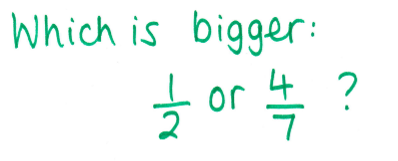

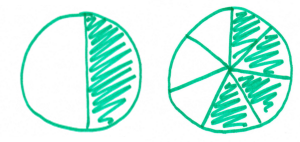
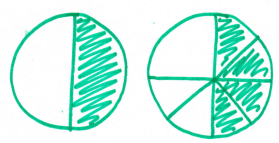
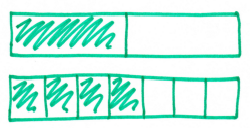

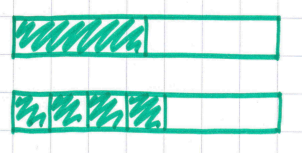

 RSS Feed
RSS Feed

Let me add one point - the bar model connects very readily to a number line model, and consequently to the idea that fractions are numbers, which is a critical idea for students to understand. How we represent and extend students' understanding of fractions is going to help build toward that idea.